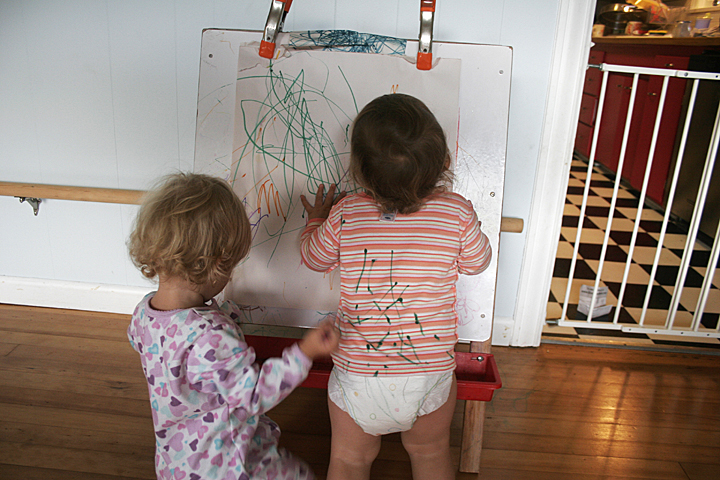Guest post by Aric Mayer.
Over the past three generations, the volume of images casually generated out of family life has increased exponentially. From the early 1900s when the Brownie camera made photography something that can be practiced easily, families have made records of important events and people, hoping perhaps to create traces and artifacts that can bind the past into the present, keeping time from marching away. There is also the strange paradox that occurs as we stage current events in order to photograph them so that we can look back at a future time and see them again. We perform for a future audience of our selves and our friends, rewriting history as we live it. As film and now digital technologies have developed, the ease and number of these types of images has gown. It is hard to know what the final impact of this flood of visual information will be on the next generation.
Exactly eighteen months ago my wife gave birth to our two children Laszlo and Chloe. In our short year and a half as a family there is already the sense that time and events are forever passing—the first tooth, the first steps, the first words … every week seems to bring another first, and with it comes loss. The temptation is there to record everything, to make an effort to translate life into a document that we can hold and thereby inoculate our selves from the losses that time brings. That would be impossible, of course, but it doesn’t stop me from trying, as in the process I have accrued 20,000 photographs of our personal lives together.
I recognize that when I am photographing, I am not simply recording events, but rather am converting them into frozen dioramas that do not necessarily recall the moments that they come out of. It is entirely possible to make a beautiful picture in the middle of crying and chaos. Likewise visual chaos can be made out of the mundane.
The photograph above is one of my favorites. Laszlo is drawing on paper. Chloe is drawing on Laszlo. And I am converting the scene into an image that frames them in that moment, creating a drawing of my own. It speaks to the multiple ways that we as families leave un-erasable marks on each other at so many levels.
The taking of family photographs is not simply a way of stopping time or recording the present for future consideration. It is also a way of organizing how we see ourselves. After a day with my children, I still on occasion set up a slideshow on my computer and watch my photographs from that day for half an hour or more. Even though I was with them in person for the day, the photographs bring something different than our relational interactions. These images are also about me. Not in a narcissistic sense, although we must be careful how heavy handed we are in shaping our children’s images of self. These pictures contribute to how I see them and to how I organize my understanding of their place in my life. Included are pictures of the crying, scrapes and bruises, bad days, the other half of the picture. It is an intensely personal body of photographs. And by the time my children are in their early twenties, they will inherit hundreds of thousands of these images. Along the way I will select a few thousand that stand out for me. Who knows what these will mean to them? What will we even do with such an amount?
Editors Note: The National Gallery of Art hosted a show titled “The Art of the Snapshot” in 2007.

National Geographic photographer David Doubilet figures he has spent more than half of his life underwater. The 62-year-old will dry out long enough, though, to give a Thursday talk at the McCoy Community Center for the Arts in New